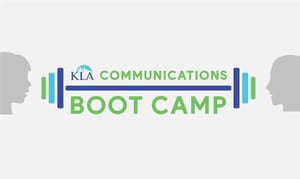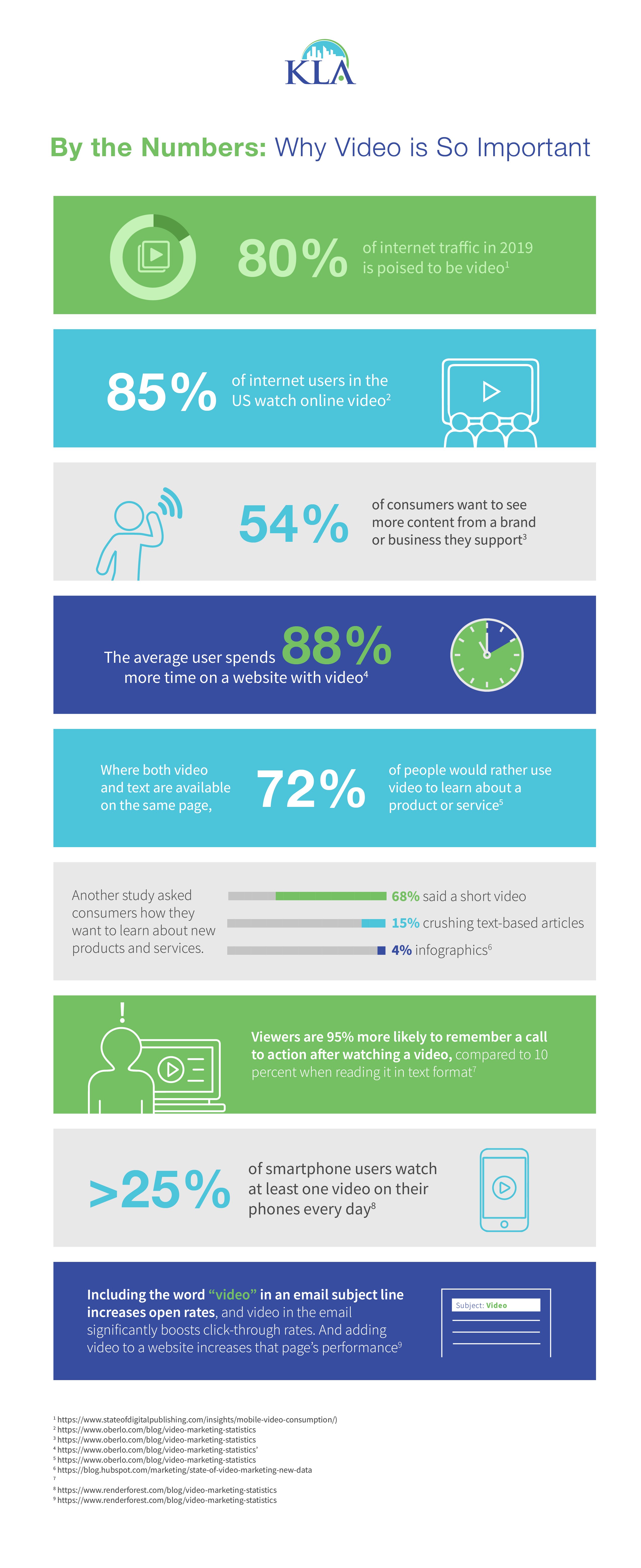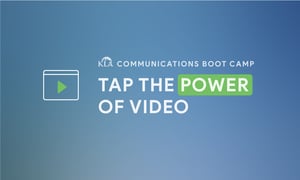 This is part of our ongoing KLA Communications Boot Camp series. We've covered website content (Website Content that Works) and blog posts (Writing Winning Blog Posts) and now turn our attention to where everyone's attention already is: VIDEOS.
This is part of our ongoing KLA Communications Boot Camp series. We've covered website content (Website Content that Works) and blog posts (Writing Winning Blog Posts) and now turn our attention to where everyone's attention already is: VIDEOS.
If you haven’t considered how video can boost your local sustainability and climate action goals, now is the time and this is the place to get started.
We produced several videos for our local government clients last year (scroll to the bottom watch them) and consider it a critical element of our communications support for them moving forward.
Why?
More and more people are watching videos. Beyond entertainment, that’s how they want to consume information. It’s the key to educating and engaging.

Yes, Local Governments, This Applies to You
Local government videos often fall into two categories: flashy tourism videos and recordings of city council and other official meetings. The former is designed to appeal to people who don’t currently live in and likely will just visit your city. The latter is not compelling and likely only accessed by journalists or the  most active residents.
most active residents.
So what does that leave for the majority of your city residents? Remember the stats from above that people watch a ton of video, want more video, and choose it over any other type of information? Give them what they want, and you’ll get more awareness and engagement as a result.
Here are just a few examples of when and how you could use video on your local climate/sustainability/resilience work:
-
Pre-event promo
-
Boost enthusiasm for an upcoming event
-
Post-event recap
-
Here’s a video example from Orlando Bike to Work Day 2015, a short video that they could have used in 2015 to take delivery on a successful event, promote biking to work year-round, and to promote a similar 2016 event.
-
Inform residents about a program
-
Often called “explainer” videos, you can introduce a new program or give an update on an ongoing initiative. Here’s how Denver did that for their Sustainable Neighborhoods program video.
-
How To
-
YouTube is a maze of instructional videos, but they can be super helpful for cities to do some basic education on things like energy efficiency, biking and transit, composting and recycling. Here’s an Austin, TX, video about how to use the green organics bin.
-
Boast an Achievement
-
Sure, you could write a press release and ideally the local TV station will pick it up. But then that news clip is gone. Produce your own short video about a policy or program success, and it can be used over and over again. Here’s how San Diego did a video on their new smart streetlights.
-
Call to Action
-
To meet our climate and sustainability goals, we all need our residents to do (or not do) something. It’s worth repeating this statistic: Viewers are 95% more likely to remember a call to action after watching a video, compared to 10 percent when reading it in text format. So show it, don’t tell it. Here’s a simple recycling PSA video from Denver and a clothing and textile recycling video from San Francisco.
-
Give Your Community a Voice
-
We’ve all seen those “person on the street” video where you ask random people what they think about a certain topic. You can easily collect these even with a smartphone and incorporate real people in your community.
-
Show Action and Success
-
Interview people who have already taken action (installing solar panels, taking a workforce training course, carpooling) about what they did, why they did it and the benefits. This is a great way to make your Call to Action feel more tangible and achievable.
-
Go Live
-
With the right audience (i.e. youth) live streaming video like a Facebook Live event can work well. Here is a breakdown of reasons to use Facebook Live and a Facebook Live how-to guide.
Tips and Tricks of the Trade
We learned a lot as we've worked internally and with clients on videos, and we recently sat down with our video production partner -- David Pichette of Mainstage Media -- to talk about the process and best practices.
-
Storyboarding is key. Start by thinking about your goals, how different elements are related, and the end use.
-
Think about people who watch but don’t listen. 85% of Facebook videos are watched without sound. Maybe you’re watching at work, on public transit, or other situations where your engagement is visual not auditory.
There are several ways to control for that. Have amazing visuals. Show a compelling story. Or simply add text. You can have embedded text (our video for New Bedford is an example) or a separate track that can be enabled on video players so it shows up more like captions.
-
The length depends on the story. Sure, for most videos 1-2 minutes will be the goal. But really it’s about the story you’re trying to tell. People will watch a 30-minute tutorial on something they care about and then get annoyed by a couple seconds of pre-roll ad. You can find all sorts of evidence that tells you people want the short “snackable” videos -- and research pointing to the increasing popularity of long form videos.
In many cases, there might not be a single answer to the “length” question. Perhaps you could produce a 2-minute video for your website, and slice up a 1-minute version to show at events, and a 30-second version for social media? If you’re using the same footage, music, narration, etc, the added production cost will be minimal.
-
Is your video more like a book with chapters? Your content might lend itself to a series that allows you to transform a single, 5-minute video on a variety of topics into 5 topic-specific videos. For example, you need a video to talk about your city’s energy initiatives. One video could be on solar and live on your webpage for clean energy initiatives and be used on social media specifically about solar. Another video could be about EVs, another about energy efficiency, etc.
-
What’s the shelf life? We know that local governments are not flush with a massive advertising budget and might not have the luxury of producing multiple videos every year -- especially for a specific department or initiative. But your residents want fresh content, so you’ll need to walk the line between making the video evergreen and something that people want to watch and feels authentic.
-
Animation is a win-win-win. Often for minimal added production cost, you can add in animation elements (or just have a full animation video). You can see how we worked animation into this EV video and this water efficiency video, both for Concord, MA.
Animation is particularly helpful in situations where you:
- Need to convey a complex or abstract concept
- Have a soundbite you need to cut up, so you cannot have the person speaking on screen.
- Want to spice up the video but don’t have access to or can’t afford high quality video or imagery.
Here’s an example from Austin, TX, of an animated video. And another example of animation from Missassagua in Canada.
-
Get the right footage. If you are going to invest in professional videography, make the most of it. Reserve space, obtain permits and line up interviews in advance. Have a detailed shot list. Request still photography in addition to video footage so you can beef up your image library. Capture drone footage (usually requires permits) as aerial footage can be stunning and used in many ways.
-
A starting point for buy in. Want to incorporate video but need to get the green light -- and budget -- from above? Looking at the statistics above, it’s a sure bet that your boss, funder, elected official or other decision-maker consumes video. Ask them to think about the amount and type of videos they watch, how often and how it impacts their awareness and actions.
How We Did it for Indianapolis, Concord and New Bedford
As part of ramping up our communications services last year, we developed a series of videos for clients with more in the works:
Thrive Indianapolis
Goal: Introduce the Thrive Indianapolis sustainability and resilience planning process
Use: Website, social media and screen at meetings/community events
Thrive Indianapolis from Kim Lundgren on Vimeo.
Concord
Goal: 3-part series to educate Concord residents about electric vehicles, water, and emergency preparedness; how each topic relates to sustainability and climate resilience; what the Town is doing and what each individual can do
Use: Website, social media
Concord: Climate Resilience and Smart Water Management from Kim Lundgren on Vimeo.
Concord: Climate Resilience and Community Preparedness from Kim Lundgren on Vimeo.
Concord: Electric Vehicles from Kim Lundgren on Vimeo.
New Bedford
Goal: Introduce New Bedford Resilient and the upcoming climate resilience planning process
Use: Website, social media
New Bedford Resilient from Kim Lundgren on Vimeo.
In terms of sheer numbers of people you reach and the ability to effectively engage them, a press release, local news story or fancy report can't accomplish what video can.
KLA is proud to offer Communications services -- including video -- to local governments. Contact us today to learn more.
This is the latest installment of our KLA Communications Boot Camp -- a series of blog posts, podcasts, guidebooks and trainings we will offer throughout the year focused on enhancing communications and community outreach skills. Previous resources include:
![]()



